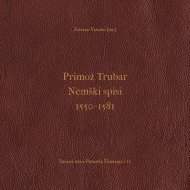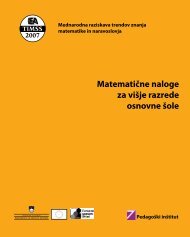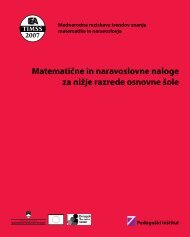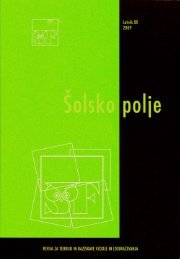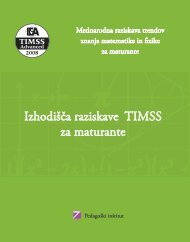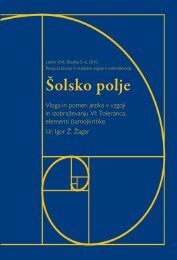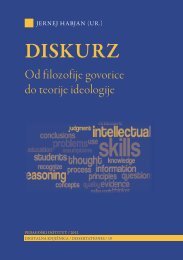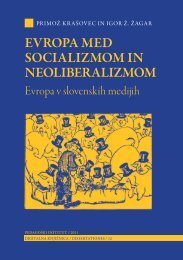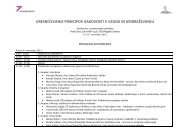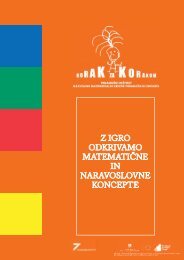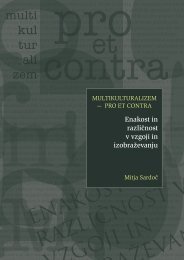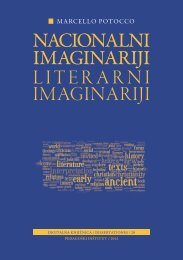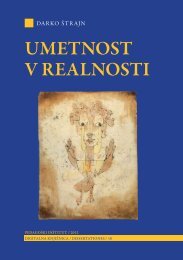118 ŠOLSKO POLJE LETNIK <strong>XX</strong> ŠTEVILKA 5/67. Depths of critical discourse analysis versus breadths of content analysisContent analysis has been very helpful for definition of topics, but evenresults obtained cannot sufficiently account for the subtler ideologicalprocesses in texts. Critical discourse analysis (CDA) can give more detailedexplanations of such relations and therefore is a logical continuationof any content analysis; where a content analysis gives breadth and generalfeeling, a CDA framework provides depth of details of vaguer notionssuch as ideologies, beliefs, coercion but also strategies of representation,mitigation and justification encoded in the actual language use. Whilecontent analysis tells us if a removal happened it doesn’t tell us how it happened,i.e. how it was constructed in the text. The text below:You will be aware that at the request of the High representative the NATOSecretary General and the SACEUR have authorized SFOR to occupy and controla number of Broadcasting Facilities in the RS. This action took place this morning.This action was taken following the grotesque distortion of the press conferencewith Judge Louise Arbour, which was broadcast by SRT on Sunday, 28 September.The High representatives recommendation was made on the basis of the mandategiven to him under the terms of the Sintra Declaration specifically paragraph 70which empowers him to act against any media outlet whose output is in persistentand blatant contravention of either the spirit or letter of the Peace Agreement.The apology and rebroadcast of Judge Arbour’s interview by SRT was, althoughwelcome, frankly too little too late. In our statement last night we made it clear thatfurther action was under consideration. “NATO Secretary-General and SACEURat the request of the HR authorized SFOR to occupy and control a number ofBroadcasting Facilities in the RS”, October, 1, 1997is about an act of SFOR’s occupation of the broadcasting facilities. It can becoded as a topic ‘OHR decisions, laws, occupying premises’ but no contentanalysis would reveal that such a decision was presented as completelycommonsensical at the time. SFOR, at the request of the HR Westendorp,committed the act of open coercion as a result of the Republic Srpska’s mainmedia ‘distorting’ Louise Arbour’s press conference broadcast followed by ajournalist’s commentary. The year 1997 was certainly not the prime time ofBiH media’s objectivity and professionalism and although the SRT, perhapsreluctantly, came with an apology, this was still considered to be ‘franklytoo little too late’. Through the combination of an adjunct expressing thespeaker’s attitude followed by a metaphor with a condescending overtone,OHR made a case and justified a military seizure of SRT on the premises ofbad journalism legitimizing it as a threat to Dayton and democratization. Notonly did this language speak of a one-time sanction but of a contingency
THE VOICE OF AN AGENDA-SETTING AUTHORITY - CONTENT CHARACTERISTICS ...119plan in case similar things happened in the future enacted in a semi-performativeof warning committing to ‘further action...under consideration’.In the following paragraph, it is not stated what powers or internationalprovisions authorize the OHR and SFOR to act and occupy the premises of abank that has been involved in illegal business operations. If BiH citizens wereto construct their social identities from this text, they would be even more passivizedseeing that none of the local police or authorities are mentioned, andwould probably be misled to believe that the OHR has the power to do it andwill do it instead. The linguistic choices used to describe this joint activity areparticularly interesting as there are traces of military/secret service discourses(e.g. the operation was well-planned and well-executed, SFOR maintained asafe and secure environment, there was no outside-interference etc.).Early this morning, representatives of the Office of the High representative, withthe strong support of SFOR, entered the main branch of Hercegovačka Banka inMostar, retrieving documentation required by the Provisional Administrator, TobyRobinson. The operation was well-planned and well-executed. While SFOR wasmaintaining a safe and secure environment, the needed bank records and vaultswere secured. There was no outside-interference.” High representative welcomesoperation securing records of Hercegovačka Banka”, April, 18, 2001A great deal of OHR’s main topics dealt with removals and bringingnew legislation which were justified with the negative Other representationof BiH politicians by distinguishing between the good (European) andthe bad (Balkan) principle:“The Balkans as a pejorative term have returned to themselves, and among theBalkan nations there is a competition over which one belongs to the Balkans, whichmeans is lost, and which one has managed to escape the dirt, corruption and hatredof the Balkans and can be counted as a part of Europe, that means of civilization.”This also goes for Bosnia and Herzegovina... I believe this is the only way in whichBiH can become a democratic, self-sustaining and self-confident state. This is theessence of Europeanization. “The HR discusses Protectorate in DANI, This is not ourcountry”, 3 March 2000In his discussion of the Bosnian protectorate, the HR Petritsch quotes anAustrian source, Karl Markus Gauss, who happens to be a Balkans expert.This is also a hortatory report as it implicitly prescribes a norm through a setof descriptions of what the norm is. As Petritsch himself is considered to bean expert on the Balkans, Gauss’s credibility and critical statements aboutBiH are not brought into question. After the quotation, Petritsch says ‘it is theonly way for BiH to become a democratic, self-sustaining and self-confidentstate’ and that this is ‘the essence of Europeanization.’
- Page 3:
VSEBINA LETNIK XX ŠTEVILKA 5/6 Z
- Page 7 and 8:
UVODNA NOTICAIgor Ž. ŽagarTole pi
- Page 9 and 10:
ZA KAJ GRE V KAD - PREGLEDZGODOVINE
- Page 11 and 12:
ZA KAJ GRE V KAD - PREGLED ZGODOVIN
- Page 13:
ZA KAJ GRE V KAD - PREGLED ZGODOVIN
- Page 17 and 18:
ZA KAJ GRE V KAD - PREGLED ZGODOVIN
- Page 19 and 20:
ZA KAJ GRE V KAD - PREGLED ZGODOVIN
- Page 21 and 22:
ZA KAJ GRE V KAD - PREGLED ZGODOVIN
- Page 23 and 24:
ZA KAJ GRE V KAD - PREGLED ZGODOVIN
- Page 25 and 26:
ZA KAJ GRE V KAD - PREGLED ZGODOVIN
- Page 27 and 28:
DISKURZ: FOUCAULT, LACLAU TERZAPOPA
- Page 29 and 30:
DISKURZ: FOUCAULT, LACLAU TER ZAPOP
- Page 31 and 32:
DISKURZ: FOUCAULT, LACLAU TER ZAPOP
- Page 33 and 34:
DISKURZ: FOUCAULT, LACLAU TER ZAPOP
- Page 35 and 36:
DISKURZ: FOUCAULT, LACLAU TER ZAPOP
- Page 37 and 38:
DISKURZ: FOUCAULT, LACLAU TER ZAPOP
- Page 39 and 40:
DISKURZ: FOUCAULT, LACLAU TER ZAPOP
- Page 41 and 42:
DISKURZ: FOUCAULT, LACLAU TER ZAPOP
- Page 43 and 44:
DISKURZ: FOUCAULT, LACLAU TER ZAPOP
- Page 45 and 46:
DISKURZ: FOUCAULT, LACLAU TER ZAPOP
- Page 47 and 48:
DISKURZ: FOUCAULT, LACLAU TER ZAPOP
- Page 49 and 50:
TOPOI IN CRITICAL DISCOURSE ANALYSI
- Page 51 and 52:
TOPOI IN CRITICAL DISCOURSE ANALYSI
- Page 53 and 54:
TOPOI IN CRITICAL DISCOURSE ANALYSI
- Page 55 and 56:
TOPOI IN CRITICAL DISCOURSE ANALYSI
- Page 57 and 58:
TOPOI IN CRITICAL DISCOURSE ANALYSI
- Page 59 and 60:
TOPOI IN CRITICAL DISCOURSE ANALYSI
- Page 61 and 62:
TOPOI IN CRITICAL DISCOURSE ANALYSI
- Page 63 and 64:
TOPOI IN CRITICAL DISCOURSE ANALYSI
- Page 65 and 66:
TOPOI IN CRITICAL DISCOURSE ANALYSI
- Page 67 and 68:
TOPOI IN CRITICAL DISCOURSE ANALYSI
- Page 69 and 70: TOPOI IN CRITICAL DISCOURSE ANALYSI
- Page 71 and 72: TOPOI IN CRITICAL DISCOURSE ANALYSI
- Page 73 and 74: TOPOI IN CRITICAL DISCOURSE ANALYSI
- Page 75 and 76: TOPOI IN CRITICAL DISCOURSE ANALYSI
- Page 77 and 78: University of Queensland, Centre fo
- Page 79 and 80: JOURNALISTIC (RE)PRODUCTION OF HIST
- Page 81 and 82: JOURNALISTIC (RE)PRODUCTION OF HIST
- Page 83 and 84: JOURNALISTIC (RE)PRODUCTION OF HIST
- Page 85 and 86: JOURNALISTIC (RE)PRODUCTION OF HIST
- Page 87 and 88: JOURNALISTIC (RE)PRODUCTION OF HIST
- Page 89 and 90: JOURNALISTIC (RE)PRODUCTION OF HIST
- Page 91 and 92: JOURNALISTIC (RE)PRODUCTION OF HIST
- Page 93 and 94: JOURNALISTIC (RE)PRODUCTION OF HIST
- Page 95 and 96: JOURNALISTIC (RE)PRODUCTION OF HIST
- Page 97 and 98: JOURNALISTIC (RE)PRODUCTION OF HIST
- Page 99 and 100: JOURNALISTIC (RE)PRODUCTION OF HIST
- Page 101 and 102: JOURNALISTIC (RE)PRODUCTION OF HIST
- Page 103 and 104: THE VOICE OF AN AGENDA-SETTINGAUTHO
- Page 105 and 106: THE VOICE OF AN AGENDA-SETTING AUTH
- Page 107 and 108: THE VOICE OF AN AGENDA-SETTING AUTH
- Page 109 and 110: THE VOICE OF AN AGENDA-SETTING AUTH
- Page 111 and 112: THE VOICE OF AN AGENDA-SETTING AUTH
- Page 113 and 114: THE VOICE OF AN AGENDA-SETTING AUTH
- Page 115 and 116: THE VOICE OF AN AGENDA-SETTING AUTH
- Page 117 and 118: THE VOICE OF AN AGENDA-SETTING AUTH
- Page 119: THE VOICE OF AN AGENDA-SETTING AUTH
- Page 123 and 124: THE VOICE OF AN AGENDA-SETTING AUTH
- Page 125 and 126: THE VOICE OF AN AGENDA-SETTING AUTH
- Page 127 and 128: THE VOICE OF AN AGENDA-SETTING AUTH
- Page 129 and 130: THE VOICE OF AN AGENDA-SETTING AUTH
- Page 131 and 132: THE VOICE OF AN AGENDA-SETTING AUTH
- Page 133 and 134: THE VOICE OF AN AGENDA-SETTING AUTH
- Page 135 and 136: ‘68 KOT HKRATNA KRIZA EVROPSKEGAZ
- Page 137 and 138: ‘68 KOT HKRATNA KRIZA EVROPSKEGA
- Page 139 and 140: ‘68 KOT HKRATNA KRIZA EVROPSKEGA
- Page 141 and 142: ‘68 KOT HKRATNA KRIZA EVROPSKEGA
- Page 143 and 144: ‘68 KOT HKRATNA KRIZA EVROPSKEGA
- Page 145 and 146: ‘68 KOT HKRATNA KRIZA EVROPSKEGA
- Page 147 and 148: ‘68 KOT HKRATNA KRIZA EVROPSKEGA
- Page 149 and 150: ‘68 KOT HKRATNA KRIZA EVROPSKEGA
- Page 151 and 152: ‘68 KOT HKRATNA KRIZA EVROPSKEGA
- Page 153 and 154: ‘68 KOT HKRATNA KRIZA EVROPSKEGA
- Page 155 and 156: ‘68 KOT HKRATNA KRIZA EVROPSKEGA
- Page 157 and 158: ‘68 KOT HKRATNA KRIZA EVROPSKEGA
- Page 159 and 160: POVZETKI/ABSTRACTSZA KAJ GRE V KAD
- Page 161 and 162: POVZETKI / ABSTRACTS159NOVINARSKA (
- Page 163 and 164: POVZETKI / ABSTRACTS161‘68 AS PAR
- Page 165 and 166: AVTORJI/AUTHORSRuth WodakRuth Wodak
- Page 168 and 169: 166 ŠOLSKO POLJE LETNIK XX ŠTEV
- Page 170 and 171:
168 ŠOLSKO POLJE LETNIK XX ŠTEV
- Page 172:
ZAHVALARevija Šolsko polje izhaja



